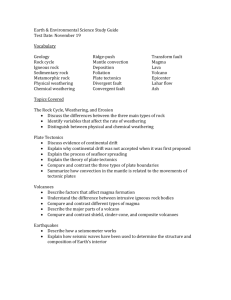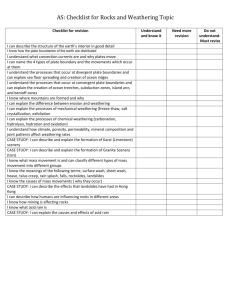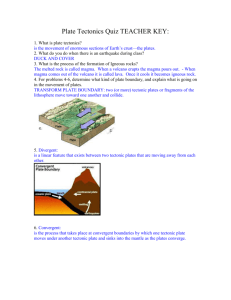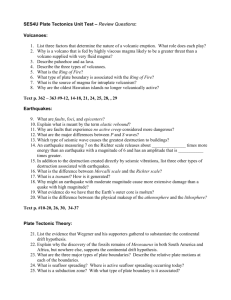Earth Science – Quiz 2
advertisement
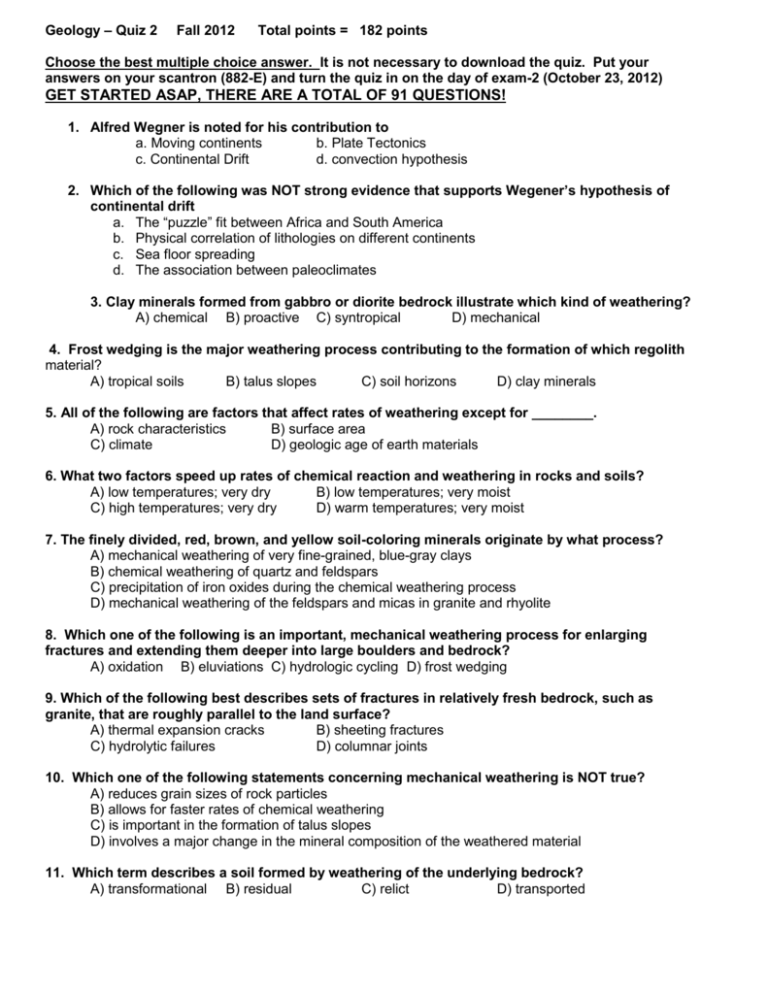
Geology – Quiz 2 Fall 2012 Total points = 182 points Choose the best multiple choice answer. It is not necessary to download the quiz. Put your answers on your scantron (882-E) and turn the quiz in on the day of exam-2 (October 23, 2012) GET STARTED ASAP, THERE ARE A TOTAL OF 91 QUESTIONS! 1. Alfred Wegner is noted for his contribution to a. Moving continents b. Plate Tectonics c. Continental Drift d. convection hypothesis 2. Which of the following was NOT strong evidence that supports Wegener’s hypothesis of continental drift a. The “puzzle” fit between Africa and South America b. Physical correlation of lithologies on different continents c. Sea floor spreading d. The association between paleoclimates 3. Clay minerals formed from gabbro or diorite bedrock illustrate which kind of weathering? A) chemical B) proactive C) syntropical D) mechanical 4. Frost wedging is the major weathering process contributing to the formation of which regolith material? A) tropical soils B) talus slopes C) soil horizons D) clay minerals 5. All of the following are factors that affect rates of weathering except for ________. A) rock characteristics B) surface area C) climate D) geologic age of earth materials 6. What two factors speed up rates of chemical reaction and weathering in rocks and soils? A) low temperatures; very dry B) low temperatures; very moist C) high temperatures; very dry D) warm temperatures; very moist 7. The finely divided, red, brown, and yellow soil-coloring minerals originate by what process? A) mechanical weathering of very fine-grained, blue-gray clays B) chemical weathering of quartz and feldspars C) precipitation of iron oxides during the chemical weathering process D) mechanical weathering of the feldspars and micas in granite and rhyolite 8. Which one of the following is an important, mechanical weathering process for enlarging fractures and extending them deeper into large boulders and bedrock? A) oxidation B) eluviations C) hydrologic cycling D) frost wedging 9. Which of the following best describes sets of fractures in relatively fresh bedrock, such as granite, that are roughly parallel to the land surface? A) thermal expansion cracks B) sheeting fractures C) hydrolytic failures D) columnar joints 10. Which one of the following statements concerning mechanical weathering is NOT true? A) reduces grain sizes of rock particles B) allows for faster rates of chemical weathering C) is important in the formation of talus slopes D) involves a major change in the mineral composition of the weathered material 11. Which term describes a soil formed by weathering of the underlying bedrock? A) transformational B) residual C) relict D) transported 12. Which one of the following statements best describes erosion? A) disintegration and decomposition of rocks and minerals at the surface B) movement of weathered rock and regolith toward the base of a slope C) the process by which weathered rock and mineral particles are removed from one area and transported elsewhere D) the combined processes of leaching, eluviation, and mass wasting 13. Which term best describes those processes that move weathered rock materials and soils downslope? A) podzolization B) slope sheeting C) mass wasting D) talus transfer 14. Assume that water filling a crack in a rock undergoes cycles of freezing and melting. Which of the following statement is true? A) Water expands as it melts, causing the crack walls to be pushed apart. B) Water shrinks as it freezes, causing the crack walls to be drawn closer together. C) Water expands as it freezes, causing the crack walls to be pushed apart. D) Water shrinks as it melts, causing the crack walls to be pulled closer together. 15. Which of the following best describe the E soil horizon? A) regolith zone B) erosion zone C) residual zone D) leaching zone 16. In which area would weathering by frost wedging probably be most effective? A) in a moist, tropical forest B) in cool high desert areas C) where the subsoil is permanently frozen D) in moist, temperate climates 17. From the land surface downward to the unweathered bedrock, which of the following is the correct order of the different soil horizons? A) 0, A, E, B, C, bedrock B) A, B, C, D, E, bedrock C) E, A, B, C, 0, bedrock D) D, E, C, B, A, bedrock 18. Chemical weathering is sped up by acids. The most common natural acid on the Earth’s surface is _____ a. nitric acid b. hydrochloric acid c. carbonic acid d. sulfuric acid 19. Which of the following is NOT an example of chemical weathering? a. dissolution of calcite b. breakdown of feldspar to form kaolinite c. splitting of a rock d. rusting a nail 20. Water seeping into rock fractures and then freezing causing rocks to break is known as a. exfoliation b. frost wedging c. ice breaking d. cryo-fracturing 21. Under dominant chemical weathering conditions, which rock would most likely weather faster a. granite b. marble c. sandstone d. Quartzite 22. The strongest evidence that supports the birth of Plate Tectonics is a. the logical connection between South America and Africa b. The union between continental shelves as opposed to continental shorelines c. The overwhelming evidence of fossils that can’t swim across seas d. The mapping of the sea floor and geological activity that takes place 23. The lithosphere is composed of a. both oceanic crust and sea floor b. both continental crust and continental shelf material c. both continental crust and plate material d. both continental crust and oceanic crust 24. The San Andreas fault is a classic example of a. One plate diving beneath another b. One plate sliding past another plate c. One plate separating from another plate d. One plate converging into another 25. The process of convection is defined by a. the upwelling of gasses through solid material b. heat transfer through a solid c. the rising and cooling of liquid material creating circular motions d. heat transfer within the rocks 26. ________ was an ancient reptile that lived in South America and Africa during the late Paleozoic. A) Granopteris B) Monastarious C) Glossopteris D) Mesosaurus 27. In the early part of the twentieth century, ________ argued forcefully for continental drift. A) Karl Wagner B) Jack Pierce C) Alfred Wegener D) Bill Kohl 28. The former late Paleozoic supercontinent is known as ________. A) Pandomonia B) Pancakea C) Pangaea D) Panatopia 29. The ________ is an example of an active, continent-continent collision. A) Arabian Peninsula slamming into North Africa under the Red Sea B) westward movement of the South American plate over the Nazca plate C) northern movement of Baja California and a sliver of western California toward the Hawaiian Islands D) northward movement of India into Eurasia 30. Pull-apart rift zones are generally associated with a ________ plate boundary. A) transform B) divergent C) convergent D) all plate boundaries 31. Linear, magnetic patterns associated with mid-ocean ridges are configured as ________. A) concentric circles about a rising plume of hot mantle rocks and magma B) reversed magnetizations along the rift valleys and normal magnetizations along the ridge C) normal and reversed magnetized strips roughly parallel to the ridge D) normal and reversed magnetized strips roughly perpendicular to the ridge axis 32. A typical rate of seafloor spreading in the Atlantic Ocean is ________. A) 2 feet per year B) 0.1 inches per year C) 20 feet per year D) 2 centimeters per year 33. Which of the following energy sources is thought to drive the lateral motions of Earth's lithospheric plates? A) gravitational attractive forces of the Sun and Moon B) electrical and magnetic fields localized in the inner core C) export of heat from deep in the mantle to the top of the asthenosphere D) swirling movements of the molten iron particles in the outer core 34. Which of the following statements apply to the asthenosphere, but not the lithosphere? A) zone in the upper mantle that deforms by plastic flowage B) cool, rigid layer of crust and upper mantle that forms the tectonic plates C) deforms mainly by brittle fracturing and faulting D) partial melting of rising granitic plumes produces huge volumes of basaltic magma 35. New oceanic crust and lithosphere are formed at ________. A) divergent boundaries by submarine eruptions and intrusions of rhyolitic magma B) convergent boundaries by submarine eruptions and intrusions of rhyolitic magma C) divergent boundaries by submarine eruptions and intrusions of basaltic magma D) convergent boundaries by submarine eruptions and intrusions of basaltic magma 36. Cooler, older, oceanic lithosphere sinks into the mantle at ________. A) subduction zones along convergent plate boundaries B) transform fault zones along divergent plate boundaries C) rift zones along mid-ocean ridges D) sites of long-lived, hot spot volcanism in the ocean basins 37. Deep ocean trenches are surficial evidence for ________. A) rifting beneath a continental plate and the beginning of continental drift B) sinking of oceanic lithosphere into the mantle at a subduction zone C) rising of hot asthenosphere from deep in the mantle D) transform faulting between an oceanic plate and a continental plate 38. A transform plate boundary is characterized by ________. A) stratovolcanoes on the edge of a plate and shield volcanoes on the adjacent plate B) two converging oceanic plates meeting head-on and piling up into a mid-ocean ridge C) a divergent boundary where the continental plate changes to an oceanic plate D) a deep, vertical fault along which two plates slide past one another in opposite directions 39. Which one of the following is an important fundamental assumption underlying the plate tectonic theory? A) Earth's magnetic field originates in the outer core. B) Earth's surface area has been essentially constant over time. C) Radioactive decay slows down at the extreme pressures of the inner core. D) Earth's ocean basins are very old and stable features. 40. The modern-day Red Sea is explained by plate tectonics theory because it is ________. A) a tiny remnant of a once immense ocean that was closed as Africa moved toward Asia B) the site of a transform fault along which Arabia is moving away from Africa C) a rift zone that may eventually open into a major ocean if Arabia and Africa continue to separate D) a rare example of a two-continent subduction zone where the African continental plate is sinking under the Arabian continental plate 41. The volcanoes and deep valleys of east Africa are related to a ________. A) continental rift along which parts of the African continent are beginning to slowly separate B) fault allowing Arabia to slip westward past east Africa and penetrate into Turkey C) transform fault aligned with the Red Sea carrying the Arabian and African blocks in opposite directions D) continental collision zone between Africa and the Zagros Mountains along the southern margin of Eurasia 42. The Aleutian Islands occur at a ________. A) convergent boundary on a volcanic arc above a northward-subducting Pacific plate B) transform boundary where North America has moved towards Alaska C) divergent boundary where shield volcanoes are forming D) convergent, continental margin with uplifted fault blocks, much like those of the Basin and 43. Early results of the Deep Sea Drilling Project clearly justified the conclusion that ________. A) the oceans have not always contained most of Earth's water B) the ocean basins are relatively young; no seafloor with an age in excess of 180 million years was ever found C) Proterozoic rocks are found only as seamounts in the deepest parts of the ocean basins D) the youngest sediments were deposited directly on the oldest seafloor basalts 44. ________, a common mineral found in igneous rocks, is the most abundant mineral in detrital sedimentary rocks. A) Calcite B) Orthoclase C) Quartz D) Biotite Match the sediment with the appropriate rock name. A. sand B. silt C. gravel D. clay 45. ________ sandstone 46. ________ shale 47. ________ conglomerate 48. ________ mudstone 49. Compaction is a very important part of the lithification process for which of the following sediments? A) gravel B) sand C) mud D) cobble 50. A cherty limestone would contain which major constituents? A) iron oxide, calcite B) silica; iron oxide C) clay minerals D) silica; calcite 51. ________ sandstone contains abundant feldspar, suggesting that the sand was derived by weathering and erosion of granitic bedrock. A) Quartz-rich B) Lignitic C) Arkosic D) Oolitic 52. ________ cement produces bright-red and yellow colors in some sandstone. A) Clay B) Calcite C) Quartz D) Iron oxide 53. What is the main difference between a conglomerate and a sedimentary breccia? A) Breccia clasts are angular; conglomerate clasts are rounded. B) A breccia is well stratified; a conglomerate is poorly stratified. C) Breccia clasts are the size of baseballs; conglomerate clasts are larger. D) Breccia has a compacted, clay-rich matrix; conglomerate has no matrix. 54. Which statement concerning sedimentary rocks is not true? A) They may contain fossils that provide clues about ancient life forms. B) They probably show some evidence of stratification. C) They were originally deposited at depth below the bottom of the sea. D) They are composed of particles derived from weathering and erosion of other rocks. 55. Which type of limestone consists mainly of tiny, marine fossils composed of calcite? A) dolostone B) chert C) coquina D) chalk 56. ________ is not a common cementing agent for sandstones. A) Quartz B) Calcite C) Fluorite D) Iron oxides 57. Detrital sedimentary rocks are classified (named) based on the ________. A) colors of the cementing minerals B) grain sizes of the detrital particles C) compositions of soluble minerals D) degree of compaction and lithification 58. Flint, chert, and jasper are microcrystalline forms of ________. A) quartz (SiO2) B) hematite (Fe2 O3) C) halite (NaCl) D) calcite (CaCO3) 59. Sedimentary rocks account for about what percentage of the Earth's outermost 10 kilometers of rock (first percentage). Also, what percentage of the Earth's continental area is covered by sedimentary rocks (second percentage)? A) 5%; 75% B) 3.5%; 100% C) 65%; 10% D) 85%; 100% 60. Which of the following sedimentary rocks would you expect to have originally been deposited by fast-moving streams? A) mudstone B) oolitic limestone C) greywacke D) conglomerate 61. ________ is the most common type of chemical sedimentary rock. A) Limestone B) Chert C) Phosphate rock D) Quartz sandstone 62. ________ is a form of calcium carbonate. A) Travertine B) Chert C) Lignite D) Gypsum 63. Which one of the following is not a chemical sedimentary rock or evaporite? A) shale B) bedded gypsum C) cherty dolostone D) oolitic limestone 64. In 1980, ________ was the first Cascade Range volcano to erupt since Mt. Lassen, California, in 1915-16. A) Mt. Rainier B) Mt. Shasta C) Kilauea D) Mt. St. Helens 65. Which type of basaltic lava flow has a fairly smooth, unfragmented, ropy surface? A) aa B) pegmatitic C) pahoehoe D) scoria 66. ________ is a major dissolved volatile constituent in both magmas and volcanic gases. A) Water B) Carbon monoxide C) Hydrogen chloride D) Methane 67. Volcanic bombs originate ________. A) as laser-guided, granite blocks launched from a supersonic jet B) as blocks of volcanic rock ejected from an erupting volcanic crater C) as erupted magma blobs that partly congeal before falling to the ground D) as ash particles that join together in the eruptive plume and fall as cobble-sized objects 68. ________ magma is the most abundant type of magma erupted at oceanic spreading centers. A) Basaltic B) Granitic C) Andesitic D) Pegmatitic 69. Why would a plume of solid silicate rock rising slowly from deep in the mantle begin melting as it neared the base of the lithosphere? A) The rock heats up and expands at lower pressures, causing it to liquefy. B) Temperatures remain high as lowered pressures decrease melting temperatures. C) The lowered pressures cause rapid heat loss accompanied by melting. D) none of the above 70. Pockets of magmas can be formed by the melting of deep continental crust heated by the intrusion of other magmas. Which of the following correctly describes this process? A) Intrusion of basaltic magma causes deep crustal rocks to melt, producing andesitic or rhyolitic magmas. B) Intruded rhyolite magma causes basalt magma to form by melting of granite. C) Intrusion of diorite magma causes basalt magma to melt from peridotite. D) All of the above correctly describe the process. For the following items, please choose from one of the following answers. A. shielded volcanoes B. composite/stratovolcanoes C. cinder cones 71. ________ massive, gently sloping volcanoes built of successive, basaltic lava flows 72. ________ large, fairly steep-sided cones composed of lavas and pyroclastic layers 73. ________ small basaltic cones built during one, short, eruptive episode 74. ________ the volcanoes of southwestern Alaska and the Aleutian Islands 75. ________ the big volcanoes of Hawaii 76. Which statement about the May, 1980, eruption of Mount St. Helens is false? A) During the eruptive period, the mountain peak was substantially built up by new lava flows and pyroclastic debris. B) Plumes of ash rose high into the atmosphere during the major eruptive events. C) Mudflows accompanied the major eruptive events. D) The most powerful explosive event was preceded by a massive landslide. 77. Which type of basaltic lava flow has its surface covered with sharp-edged, angular blocks and rubble? A) scoria B) pahoehoe C) pillow lava D) aa 78. The Columbia Plateau in Washington and Oregon is ________. A) a flood basalt plateau B) a thick stack of welded-tuff layers C) a caldera filled with rhyolite lava flow. D) a field of large stratovolcanoes 79. Which kind of eruptive activity is most likely to be highly explosive? A) Lava flows from a large shield volcano on an oceanic island. B) Fissure eruptions feeding lava to flood basalt accumulations. C) Eruptions of big, continental margin, composite cones or stratovolcanoes. D) Lava flows from a large cinder cone complex. 80. Which one of the following statements is not true? A) Melting temperatures of silicate rocks increase with increased pressure. B) Melting temperatures of silicate rocks are lowered by small amounts of water. C) Basalt magmas in general have higher temperatures than rhyolite magmas. D) When magma reaches the surface, its dissolved gas content increases. 81. Mount St. Helens is ________. A) a basaltic cinder cone C) a basaltic shield volcano B) an explosive stratovolcano D) a small, welded tuff cone 82. The average composition of rocks comprising a large composite cone or stratovolcano is similar to a (an) ________ magma. A) basaltic B) ultramafic C) andesitic D) rhyolitic 83. A ________ volcano is a very large, gently sloping mound composed mainly of basaltic lava flows. A) composite B) stratospheric C) cinder cone D) shield 84. Which of the following best describes Shiprock, a famous volcanic feature in New Mexico? A) a very recently active, basaltic cinder cone B) an extinct, highly symmetrical, composite volcanic cone C) the eroded remains of a volcanic pipe and radiating dikes D) an extinct, massive, rhyolitic shield volcano 85. Which region has the greatest concentration of currently active volcanoes? A) the coastal plain of western Africa B) European Russia and Siberia C) the area surrounding the Red Sea D) the circum-Pacific area 86. Which one of the following shows the correct order (left to right) of decreasing magma viscosity? A) rhyolite, andesite, basalt B) andesite, rhyolite, basalt C) basalt, rhyolite, andesite D) basalt, andesite, rhyolite 87. Why do magmas rise toward Earth's surface? A) Magmas are more viscous than solid rocks in the crust and upper mantle. B) Most magmas are richer in silica than most crustal and upper mantle rocks. C) Magmas are mainly liquid and contain dissolved fluids such as water; most are less dense than the adjacent solid rock. D) all of the above 88. A ________ is the largest, discordant body of intrusive, igneous rock. A) lopolith B) laccolith C) pluton D) batholith 89. A ________ is an intrusive, igneous rock body that is tabular and concordant. A) laccolith B) dike C) pluton D) sill 90. A ________ is a near surface, intrusive, igneous rock body that results from local inflation of a horizontal sill. A) batholiths B) dike C) laccolith D) volcanic neck 91. Which of the following best describes the bedrock in the Sierra Nevada Mountains in California? A) basalt; dikes B) gabbro; plutoliths C) andesite; laccoliths D) granite; batholiths


